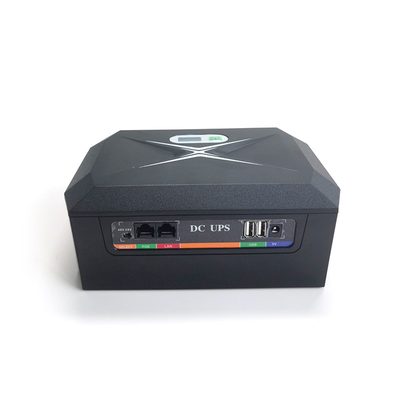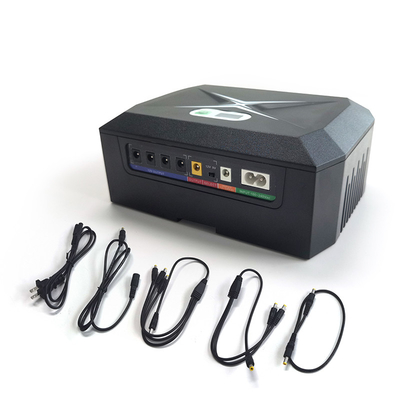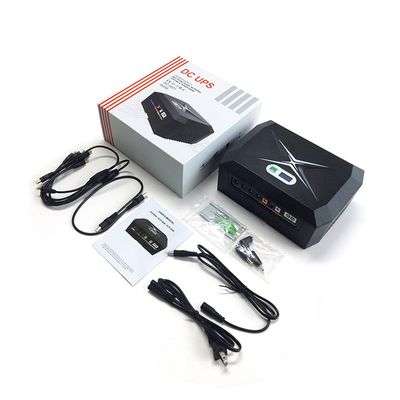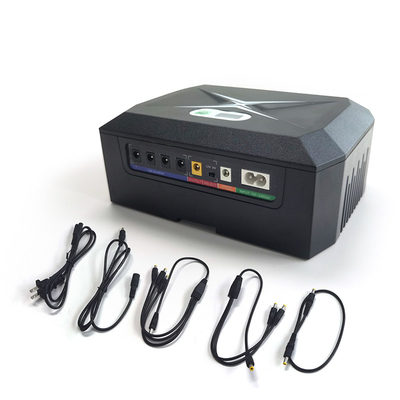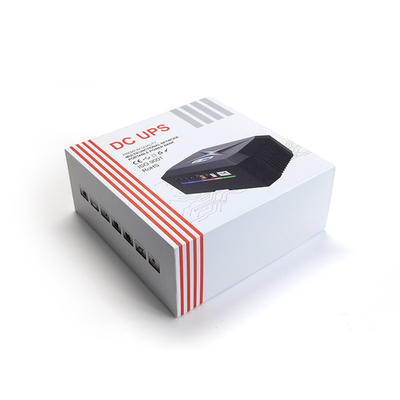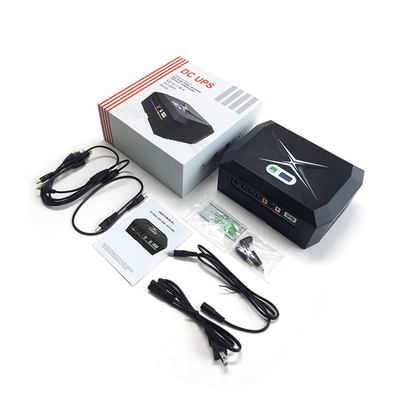-
 Ali Antonio Soto Vasquezexcelente atención
Ali Antonio Soto Vasquezexcelente atención
Rechargeable 48000mah Mini UPS Backup Power Supply For Router And Wifi Antenna
| Place of Origin | China |
|---|---|
| Brand Name | HKIVI |
| Certification | ISO 9001, RoHS |
| Model Number | DCP-60W |
| Minimum Order Quantity | Minimum order quantity: 2 sets |
| Price | Negotiable |
| Packaging Details | Single package size: 230mm*230mm*95mm |
| Delivery Time | 7-14 work days |
| Payment Terms | L/C, D/A, D/P, T/T, Western Union, MoneyGram, PayPal |
| Supply Ability | 200 sets/month |

Contact me for free samples and coupons.
WhatsApp:0086 18588475571
Wechat: 0086 18588475571
Skype: sales10@aixton.com
If you have any concern, we provide 24-hour online help.
x| Product Name | UPS Power Supply | Type | Rechargeable 48000mah Mini Portable Ups Power Supply For Router And Wifi Antenna |
|---|---|---|---|
| Output Power | 60W | Battery Capacity | 48000mah |
| Output | 5VDC/9VDC/12VDC, POE15V/24V POE 48V(Optional) | Output Current | 1~8A |
| Input Voltage | 220v 110v | Appplication | Modem,ip CCTV Camera,Router,diverter,poe,network |
| Dimensions | 214mm*158.5mm*86mm | Weight | 2.6KG |
| Highlight | 48000mah mini ups backup power supply,mini ups backup power supply for router,rechargeable ups power supply |
||
Rechargeable 48000mah Mini Portable Ups Power Supply For Router And Wifi Antenna
Uninterruptible Power Supply (UPS) is a crucial device that provides backup power to protect electronic equipment during power outages or voltage fluctuations. Here are the key things to know about UPS power supplies:
Purpose and Functionality:
A UPS Power Supply is designed to supply power to connected devices when the main power source fails or becomes unstable.
It uses a battery to generate clean, consistent power to the connected equipment, preventing data loss and potential hardware damage.
Runtime and Capacity:
UPS Power Supply units come in different capacities, measured in Volt-Amperes (VA) or Watts (W).
The runtime, or how long the UPS can power the connected devices during an outage, depends on the battery capacity and the power draw of the connected equipment.
Types of UPS:
Standby/Offline UPS: Switches to battery power only when the main power fails.
Line-Interactive UPS: Provides voltage regulation and battery backup.
Online/Double-Conversion UPS: Constantly runs the load on the inverter, providing the highest level of power conditioning.
Power Management and Monitoring:
Many UPS Power Supply units come with software that allows you to monitor the status, configure settings, and control the UPS remotely.
This includes features like automatic system shutdown, email/SMS alerts, and log reporting.
Maintenance and Battery Replacement:
UPS Power Supply batteries have a limited lifespan, typically 3-5 years.
Regular maintenance, such as battery testing and replacement, is crucial to ensure the UPS functions properly during a power outage.
Applications:
UPS Power Supply systems are commonly used to protect servers, network equipment, workstations, and other mission-critical electronics.
They are essential in environments where power reliability is crucial, such as data centers, healthcare facilities, and industrial control systems.
When selecting a UPS, consider factors like the connected load, runtime requirements, form factor, and available features. Proper installation and maintenance are also key to ensuring the UPS provides reliable backup power when needed.
![]()
| Model | DCP-60W |
|---|---|
| Input | 100-240Vac/50-60Hz |
| Output | U5B 5V/2.4A |
| DC 5V/2.4A | |
| DC 9V (12V) /2A | |
| DC 12V/5A | |
| DC 19V/3A | |
| POE 15V/1.5A | |
| POE 24V/1A | |
| POE 48V/0.6A(Optional) | |
|
Output Power (Max) |
60W |
|
Quantity/Capacity of battery |
18650/21700/32700 4-8PCS
8800mAh--48000mah selected
|
|
Operate temperature |
0℃-40℃ |
| Humidity |
10%-90%RH |
![]()
lts eight advantages
Use it whilecharging No need to wait / Easy to carry Small weight no burden / Large storagecapacity 8000-48000mAh Storage capacity / Multiplexed output Strong device compatibility / lmported chip Short circuit protection / Network monitoring Network monitoring assistant / Stable power supply Supports dual devices / Lithium battery Long lasting, safe and durable
With it
say NO to power cuts
Use Mini UPS power to power WIFI devices
Uninterruptible Power Supplies (UPS) have a wide range of application scenarios where they provide critical backup power and protection. Here are some common use cases for UPS power supplies:
Data Centers and IT Infrastructure:
UPS Power Supply systems are essential in data centers to protect servers, storage systems, and network equipment from power outages or fluctuations.
They ensure continuous operation and prevent data loss during power failures.
Telecommunications and Internet Service Providers:
UPS Power Supply units are crucial for maintaining connectivity and communications during power disruptions.
They safeguard routers, switches, and other network infrastructure in telecom and ISP facilities.
Medical and Healthcare Facilities:
UPS Power Supply systems are vital in healthcare settings to protect life-critical equipment, such as medical imaging devices, patient monitoring systems, and emergency lighting.
Uninterrupted power is essential for ensuring patient safety and continuity of care.
Industrial and Manufacturing Environments:
UPS Power Supply units are used to protect industrial control systems, programmable logic controllers (PLCs), and other mission-critical equipment from power-related failures.
They help maintain production processes and prevent costly downtime during outages.
Small and Home Offices:
UPS Power Supply devices can provide backup power for home or small office routers, modems, and other networking equipment.
This ensures internet connectivity and enables remote work or online learning during blackouts.
Audio/Visual and Entertainment Systems:
UPS Power Supply units can protect professional audio/visual equipment, such as mixing consoles, lighting controllers, and video production systems, from power disruptions.
This is crucial for live events, studio productions, and other time-sensitive applications.
Security and Surveillance Systems:
UPS Power Supply systems are used to maintain power for security cameras, access control systems, and alarm systems during power outages.
This helps ensure the continuous operation of these critical security infrastructure components.
![]()
Absolutely, here are some tips for properly sizing and installing a UPS Power Supply system to ensure reliable backup power:
Sizing the UPS:
Determine the total power consumption (in Watts or VA) of all the equipment you want to connect to the UPS.
Consider the startup power requirements of devices, as this can be significantly higher than their running power.
Select a UPS with a capacity that exceeds the total connected load by at least 20-30% to account for future growth and potential power surges.
Ensure the UPS runtime (battery capacity) meets your required backup duration needs.
Placement and Airflow:
Place the UPS in a well-ventilated area, away from direct sunlight, heat sources, or moisture.
Maintain at least 6 inches of clearance around the UPS for proper airflow and heat dissipation.
Avoid installing the UPS in enclosed cabinets or spaces that could restrict airflow.
Power Connections:
Use the appropriate power cables and outlets rated for the UPS and connected equipment.
Ensure all connections are secure and the UPS is properly grounded.
Avoid using extension cords or power strips between the UPS and the connected devices.
Battery Maintenance:
Follow the manufacturer's recommendations for battery maintenance and replacement.
Regularly test the UPS batteries to ensure they maintain their full capacity.
Replace batteries according to the manufacturer's specified lifespan, typically every 3-5 years.
Power Management Software:
Install the provided power management software on the connected computers or servers.
Configure the software to monitor the UPS status, perform automatic system shutdowns, and receive alerts during power events.
Regularly test the automatic shutdown and notification functionality.
Surge Protection:
Ensure the UPS provides adequate surge protection for the connected equipment.
Consider using additional surge protectors or line conditioners if the UPS does not have built-in surge protection.
Backup Power Testing:
Periodically test the UPS by simulating a power outage to ensure the connected devices receive uninterrupted power.
Verify that the UPS can maintain the required runtime during these tests.
Following these guidelines will help you properly size, install, and maintain your UPS system to ensure reliable backup power and protection for your critical equipment. Let me know if you have any other questions!
![]()




